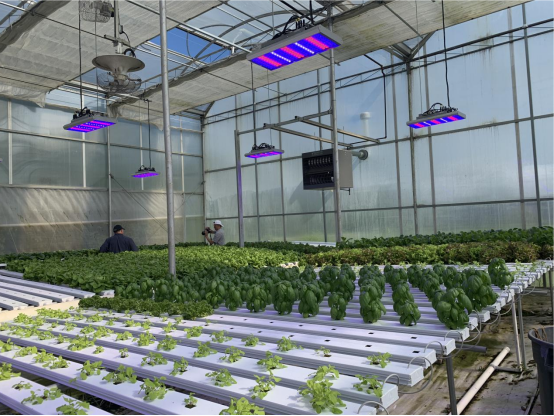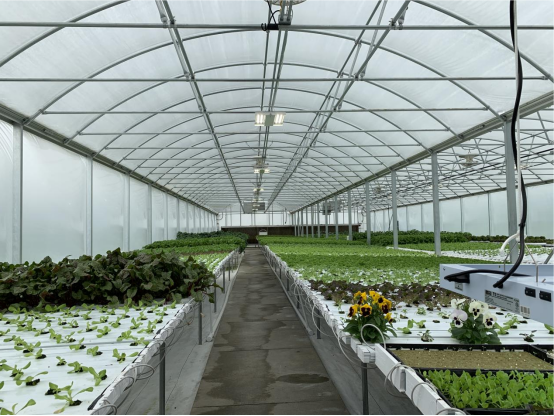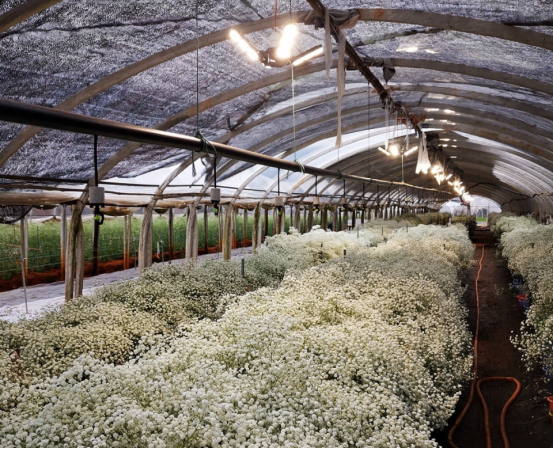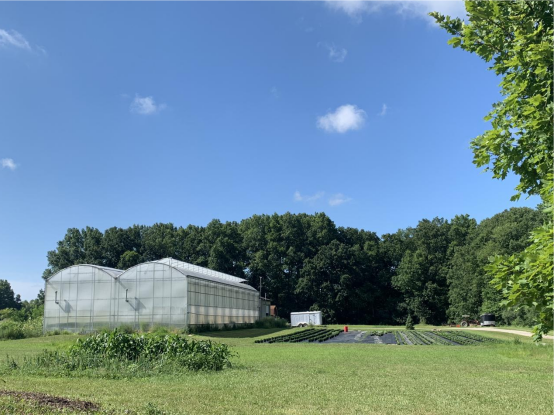Sansi LED: Sustainable LED Lighting and Integrated LED Display
Delivering premium and professional LED Display, LED Lighting, Smart City Integration solutions, trusted by over 60,000 companies worldwide everyday. From industrial lighting to commercial lighting, from outdoor advertising to XR & VR production, Sansi LED greatly improves the quality and sustainability of your business with 30 years of expert experiences.
Table of Contents
Breakthrough Greenhouse Growth: The Power of LED Lighting Solutions
4 Advantages of LED Grow Lights in Greenhouse Lighting
How to pick the right LED Greenhouse Farming Lights
Case Study Analysis

Breakthrough Greenhouse Growth: The Power of LED Lighting Solutions
The greenhouse lighting industry is experiencing a significant shift from high pressure sodium (HPS) to LED horticultural lighting. More and more greenhouses are adopting LED solutions to improve yields, reduce energy costs and ultimately increase revenue.
The benefits of LED lighting in greenhouses are well documented. Numerous studies have shown measurable improvements in crop quality and operational efficiency. With their efficient spectral tuning capabilities and long life, LED lights have become an indispensable tool in modern agriculture. Compared to traditional HPS lights, LED lights not only provide a more suitable growing environment for crops, but also significantly reduce electricity consumption, thereby reducing the greenhouse's carbon footprint.
Choosing LED greenhouse lights isn't just about achieving higher yields and better quality; it's also about embracing a more sustainable agricultural production. The widespread adoption of this technology marks a significant advancement in agricultural techniques, bringing tangible economic benefits and environmental value to farmers.

4 Advantages of LED Grow Lights in Greenhouse Lighting
Better yields
A European research team from Italy and Spain reported in a meta-analysis that incorporating LED lighting in greenhouses significantly increased tomato yields and improved quality. They found that LED lighting increased essential nutrients such as ascorbic acid and improved photosynthesis in the leaves. In short, using LED lights in greenhouses results in more and higher quality tomatoes.
Cost savings
In 2021, researchers published a study titled "Energy savings in greenhouses by transition from high-pressure sodium to LED lighting," which examined the impact of switching to LED lighting in greenhouses. Their analysis evaluated how LEDs affect the energy budget of greenhouses, taking into account both lighting and heating needs. The researchers concluded that switching to LEDs can save up to 10 to 25 percent of total greenhouse energy demand, depending on climate and initial lighting energy use.
Flexible application of light spectrum
Matching the light spectrum to specific crops and further tuning it for each growth stage is critical. The light spectrum has a significant effect on plant development. For example, red light is highly efficient for photosynthesis and promotes flowering, while blue light is essential for leaf growth and stronger stems. The optimal light spectrum for greenhouse-grown lettuce and other leafy greens is different from that needed for flowering crops. In addition, a single crop requires different light prescriptions for each stage of growth. For example, flowering crops such as cannabis require a shift in light spectrum from the vegetative to the flowering stage. Spectrum considerations are critical for any LED greenhouse lighting application.
Durability and maintenance
LEDs have a longer life and are more reliable than traditional light sources. Traditional lighting typically lasts 10,000 hours, while LEDs often exceed 50,000 hours - more than five times longer. This longer life reduces maintenance and replacement costs, and it also minimizes greenhouse disruption for fixture replacement and repairs.

How to pick the right LED Greenhouse Farming Lights
LEDs, or Light Emitting Diodes, have transformed greenhouse lighting. Unlike traditional options like fluorescent or incandescent bulbs, LEDs offer multiple benefits: energy efficiency, longer lifespan, lower heat emission, and customizable light spectrums for optimal plant growth. There are four key factors to consider when selecting LEDs for the greenhouse.
Light Spectrum
The light spectrum of LEDs is critical to plant growth. Plants have different light requirements at different stages of growth. Seedlings thrive with more blue light for photosynthesis, while flowering plants benefit from more red light. Growers should select LEDs that meet the specific light needs of their crops.
Energy Efficiency
Energy costs are a significant factor in greenhouse profitability. LEDs are energy efficient, converting more electricity into usable light than other lighting options. By choosing energy-efficient LEDs, growers can reduce their electricity bills while still providing optimal lighting for their crops.
Light Intensity and Coverage
The intensity and coverage of LED light are important considerations. Different crops require different light intensities, and growers should ensure that their LEDs meet these requirements. In addition, LED coverage should match the size of the greenhouse for even light distribution.
Dimming and control options
Certain crops require different light levels during their growth cycle. LEDs with dimming and control capabilities allow growers to adjust light output as needed. This flexibility is especially beneficial to growers who grow a variety of crops in their greenhouses.
Case Study Analysis
Tyler Farm in Cleveland, Ohio, experiences cold, wet winters with limited sunlight, adversely affecting the growth of greenhouse leafy vegetables such as lettuce. Reduced light intensity hinders photosynthesis, leading to lower yields and poor crop quality. Additionally, essential wavelengths like blue and purple light, crucial for chlorophyll and anthocyanin synthesis, are absorbed by clouds and fog, further impeding growth and color development.
To counter these challenges, Sansi LED Lighting provided 42 high-power LED fill lights tailored to the specific light spectrum needs of leafy vegetables. These LEDs ensured optimal light conditions, supporting more effective photosynthesis and nutrient synthesis.

After more than a year of using Sansi LED lighting, Tyler Farm saw a 40% increase in the overall yield of leafy vegetables and a significant improvement in produce quality, highlighting the success of Sansi’s lighting solutions in overcoming environmental challenges and enhancing crop productivity.
In conclusion, Tyler Farm's adoption of Sansi LED lighting effectively mitigated the adverse effects of limited natural light and challenging weather, demonstrating the value of advanced lighting solutions for consistent, high-quality crop production in greenhouse environments.
-
NO DATA
